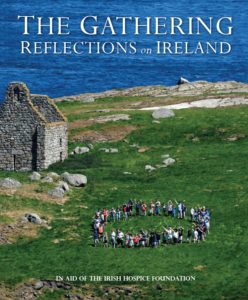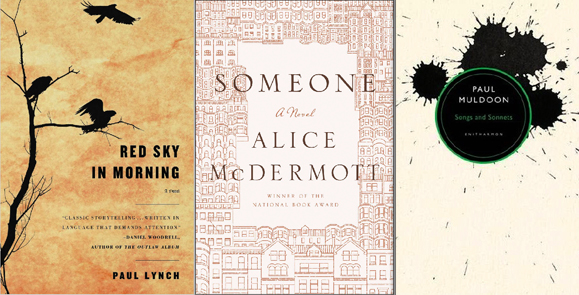Songs and Sonnets
Paul Muldoon has eleven previous volumes of poetry and has won many prizes, including the Pulitzer and the T.S. Eliot. This year, he released two books of song lyrics, and though they may not win awards, that’s not the point.
At a brisk 48 pages, Songs and Sonnets is more ear candy than brain candy. But amid the poems’ entertainment (and some truly spectacular rhymes – DDT with debt, Château Lynch-Bages with 3-car garage, “a little quilting” with “Hillbilly Hilton”), is masked the seriousness of their subjects: adultery, substance abuse, limits of knowledge and language, aging, death. These aren’t new subjects for Muldoon. The novelty is wedging them into a three-verse-and-a-bridge lyric, forcing us to acknowledge that poetry was once fettered to the lyre. Muldoon asks what it means that the two have parted company, and can or should they be rejoined?
Constituting a more traditional poetics, the six sonnets emphasize that question. As much as the songs delight with their epicurean wordplay and hailstorm of allusions (Keats to CSNY to Von Braun), they need a counterpoint. Perhaps the most direct is the final sonnet, titled “Recalculating,” as if to suggest our own potential recalculation of Muldoon’s oeuvre after this volume.
The book’s opening song also seems to prod us. Ostensibly following the banal trope of “please, fall in love with me” lyrics, as the poem moves from invoking ancient famous lovers like Heloise and Abelard to the “Gestapo asking questions,” the ineffectual pining heart turns into an active and terrifying summons: “You may have found / You can’t resist me much more.” As an opening, “Resistance” is apropos (and possibly prophetic), since anyone coming to this book skeptical of the sometimes obvious lines and easy rhymes by the Pulitzer-winning Muldoon may have to be coerced into enjoyment. Once you are, though, this collection will keep getting better and better. – Adam Farley
(Enitharmon / $24.95 / 48 pages)
Someone
No one captures the power of simplicity better than Alice McDermott. The winner of the 1999 National Book Award for Charming Billy, McDermott, born to first-generation Irish-American parents in Brooklyn, is also one of the most insightful chroniclers of the Irish-American family experience.
Her first novel in seven years, Someone is the story of Marie Commeford – Brooklyn-born like her author, though earlier. Here, McDermott weaves together various passages from seven decades of Marie’s life: age seven, sitting on her stoop and eyeing, through her thick glasses, neighbors on their way home from work as she waits for her father; a few years later, stubbornly refusing to learn how to cook out of an unexpressed fear that if she does, her mother will die; walking in Prospect Park with her brother, Gabe, who is home for good from the priesthood, as he helps her get through her first heartbreak; on the night of her wedding to a man who entered and re-entered her life by chance; being helped home from a botched cataract procedure by one of her daughters; in a nursing home, unexpectedly content with the company of one of the attendants and some angels she has recently begun to see. They flit through chronology and vary in importance, though each moment adds greatly to the portrait of Marie and of the times in which she lives.
McDermott’s quietly penetrating observations contrast with Marie’s near-sightedness, which goes beyond the physical and the thick-lensed glasses she loathes. Often, Marie doesn’t grasp what is right in front of her – sometimes out of ignorance, sometimes as a kind of defense against the world, which has changed so much in her lifetime. In this character, readers will see qualities of women they know (their mothers, their grandmothers, themselves) and glimpses into a way be being that seems to be – for better and for worse – slowly fading. Someone is a beautiful, haunting work, and, like its protagonist, is not to be underestimated. – Sheila Langan
(Farrar, Straus and Giroux / $25.00 / 234 pages)
Red Sky in Morning
A startling debut debut that’s earning serious praise on both sides of the Atlantic – lauds from Sebastian Barry and Daniel Woodrell; an advance interview in Publisher’s Weekly – Paul Lynch’s Red Sky in Morning confronts the historical pretext to the Irish Famine with unparalleled lyricism and a strong sense of the elemental forces such times can evoke in people.
Starting in 1832 in Co. Donegal and sweeping across the ocean to America and the strange mix of opportunity and strife found there in the Pennsylvania Railroad work camps, the story centers on two men: Coll Coyle and John Faller. Coyle is a tenant farmer, living with his wife and children on the estate of the Hamilton family. Faced with the prospect of eviction, Coyle seeks a word with the feckless son now in charge of his family’s fate, and in one confused second accidentally brings about the young man’s death. John Faller, the overseer who, we learn early on, was likely the young Hamilton’s real father, thus begins his pursuit of Coyle and of his family, who flee separately. The Ireland we see along Coyle’s meandering journey from his home to the city of Derry is cold, desolate and poor, and the new life that awaits him in America is not that much brighter.
Lynch’s background in film – he was the chief film critic of Ireland’s Sunday Tribune from 2007 to 2011 and has been hailed by the Irish Times as one of Ireland’s “finest film writers” – is evident throughout, particularly in some of the tropes he uses to breathe new life into the time period: complicated evil hunting down increasingly desperate good (like the eeriest of bad guys, Faller never seems to run or rush in his pursuit of Coyle); strangers along the journey whose help is invaluable but whose trustworthiness must constantly be re-evaluated. In addition, Lynch has a true gift for unexpected diction, which he uses to great effect, lending the novel a constant sense of action. Take this descriptive passage as proof: “The murmur of water and he followed til near he came upon the bloom. Brushwood hazed with luminous light then fields of tubular blue. The bluebells stood head-bowed as if quietly mourning their own quick passing or the memory that came as he kicked through their beauty of a time when to see them was small heaven itself.” – Sheila Langan
(Little, Brown & Co. / $12.99)
The Gathering: Reflections on Ireland

To commemorate the year of the highly successful “Gathering” initiative, in which members of the far-flung Irish diaspora as well as those who simply love Ireland have been encouraged to visit, The Irish Hospice Foundation has compiled a beautiful collection of over 60 stories, reflections and photographs. Edited by journalist Miriam Donohoe, it is filled with thoughtful meditations on Ireland and on being Irish, from contributors of renown – such as Bono, Colum McCann, Katie Taylor, Loretta Brennan Glucksman, Moya Doherty, Comma-nder Chris Hadfield (who waxes humorously and lyrically on Ireland from outer space) and the late Seamus Heaney – and from less famous folks who have had meaningful experiences with Ireland in the past year.
Accounts of official Gathering events, some of which made headlines and others that you might not otherwise learn of, are also included. In “The Famine Attic Experience,” Neisha Wratten travels from Adelaide to Leitrim to relive the last night her great-great-grandmother spen
t at a Carrick-on-Shannon workhouse before being sent to Australia; in the “Hide and Seek Children,” a special event to marks the return of the Slovak Jewish children who spent a year recovering in Ireland in 1948 after the Holocaust; and in the “Gathering of the Stones,” masons from Ireland and abroad construct a special dry wall structure in Offaly, symbolically incorporating granite blocks from the old immigrant docks in New York.
All proceeds benefit the Irish Hospice Foundation, which aims to encourage a re-evaluation of end of life care in Ireland. The book recently received a star-studded Manhattan launch, where actor Gabriel Bryne, who, along with Daniel Day-Lewis, is a staunch advocate for improved hospice care in Ireland, praised both the book itself and the foundation’s mission. – Sheila Langan
(The Irish Hospice Foundation / $30.00 / 256 pages)
The Broadsheet Book of Unspecified Things That Look Like Ireland
 To begin on an honest note, it must be said that this book is no great literary or artistic feat. Unlike many books of photographs, it is not a handsomely designed coffee table tome to treasure and/or to impress guests. So what is it? It’s pure fun. And a great testament to the Irish sense of humor.
To begin on an honest note, it must be said that this book is no great literary or artistic feat. Unlike many books of photographs, it is not a handsomely designed coffee table tome to treasure and/or to impress guests. So what is it? It’s pure fun. And a great testament to the Irish sense of humor.
The collection – quite literally of things that happen to look like Ireland (or in some cases were probably manipulated to) – represents the culmination of a two-year project by the Irish satirical news and culture site Broadsheet.ie. Editor Aidan Coughlan crowd sourced for images of things that looked like Ireland. (For those who’ve never taken the time to consider what the island looks like, it is most often compared to a teddy bear.) The submissions came in droves and inspired a small but steady national online phenomenon.
The photographs – a few professional-looking; most snapped with cell phones – are organized into sections, including “The Edible,” “The Uncategorizable,” and “The Natural.” There is even an entire section dedicated to chicken nuggets, most of which look highly unappealing but do indeed resemble Ireland’s geographical outline. In some of the images, Ireland is immediately recognizable (the upstanding hedge; the piece of pyrite in a Washington, D.C. museum), others less so (sorry, Gavan Flinter, I couldn’t see Ireland in the ivy growing on the side of the University of Music and Performing Arts in Vienna), but they’re all good fun and will inspire you to look for Ireland in the most unexpected places.
Even better, proceeds from the book are being donated to the Irish charity Aware, which provides information, education and support services for people struggling with depression or anxiety. – Sheila Langan
(Dufour Editions & New Island)


Leave a Reply